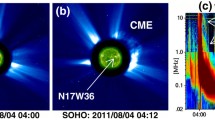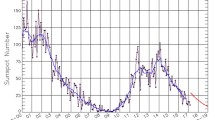Abstract
Ground level events (GLEs) occupy the high-energy end of gradual solar energetic particle (SEP) events. They are associated with coronal mass ejections (CMEs) and solar flares, but we still do not clearly understand the special conditions that produce these rare events. During Solar Cycle 23, a total of 16 GLEs were registered, by ground-based neutron monitors. We first ask if these GLEs are clearly distinguishable from other SEP events observed from space. Setting aside possible difficulties in identifying all GLEs consistently, we then try to find observables which may unmistakably isolate these GLEs by studying the basic properties of the associated eruptions and the active regions (ARs) that produced them. It is found that neither the magnitudes of the CMEs and flares nor the complexities of the ARs give sufficient conditions for GLEs. It is possible to find CMEs, flares or ARs that are not associated with GLEs but that have more extreme properties than those associated with GLEs. We also try to evaluate the importance of magnetic field connection of the AR with Earth on the detection of GLEs and their onset times. Using the potential field source surface (PFSS) model, a half of the GLEs are found to be well-connected. However, the GLE onset time with respect to the onset of the associated flare and CME does not strongly depend on how well-connected the AR is. The GLE onset behavior may be largely determined by when and where the CME-driven shock develops. We could not relate the shocks responsible for the onsets of past GLEs with features in solar images, but the combined data from the Solar TErrestrial RElations Observatory (STEREO) and the Solar Dynamics Observatory (SDO) have the potential to change this for GLEs that may occur in the rising phase of Solar Cycle 24.









Similar content being viewed by others
References
M.D. Altschuler, G. Newkirk, Sol. Phys. 9, 131 (1969)
M.J. Aschwanden, Space Sci. Rev. (2012, this issue). doi:10.1007/s11214-011-9865-x
A. Belov, H. Garcia, V. Kurt, H. Mavromichalaki, M. Gerontidou, Sol. Phys. 229, 135 (2005)
J.W. Bieber, W. Dröge, P.A. Evenson, R. Pyle, D. Ruffolo, U. Pinsook, P. Tooprakai, M. Rujiwarodom, T. Khumlumlert, S. Krucker, Astrophys. J. 567, 622 (2002)
D.S. Brown, R.W. Nightingale, D. Alexander, C.J. Schrijver, T.R. Metcalf, R.A. Shine, A.M. Title, C.J. Wolfson, Sol. Phys. 89, 181 (2003)
G.E. Brueckner et al., Sol. Phys. 162, 357 (1995)
H.V. Cane, D.V. Reames, T.T. von Rosenvinge, J. Geophys. Res. 93, 9555 (1988)
H.V. Cane, T.T. von Rosenvinge, C.M.S. Cohen, R.A. Mewaldt, Geophys. Res. Lett. 30, 8017 (2003). doi:10.1029/2002GL016580
H.V. Cane, R.A. Mewaldt, C.M.S. Cohen, T.T. von Rosenvinge, J. Geophys. Res. 111, A06S90 (2006). doi:10.1029/2005JA011071
H.V. Cane, I.G. Richardson, T.T. von Rosenvinge, J. Geophys. Res. 115, A08101 (2010). doi:10.1029/2009JA014848
E.W. Cliver, Sol. Phys. 75, 341 (1982)
E.W. Cliver, Astrophys. J. 639, 1206 (2006)
E.W. Cliver, S.W. Kahler, M.A. Shea, D.F. Smart, Astrophys. J. 260, 362 (1982)
E.W. Cliver, S.W. Kahler, H.V. Cane, M.J. Koomen, D.J. Michels, R.A. Howard, N.R. Sheeley Jr., Sol. Phys. 89, 181 (1983)
E.W. Cliver, S.W. Kahler, D.V. Reames, Astrophys. J. 609, 901 (2004a)
E.W. Cliver, N.V. Nitta, B.J. Thompson, J. Zhang, Sol. Phys. 225, 105 (2004b)
E.W. Cliver, B.J. Thompson, G.R. Lawrence, A.N. Zhukov, A.J. Tylka, W.F. Dietrich, D.J. Reames, M.J. Reiner, R.J. MacDowall, A.G. Kosovichev, A.G. Lang, in Proc. 29th In. Cosmic Ray Conf., Pune (2005), p. 121
C.M.S. Cohen, R.A. Mewaldt, R.A. Leske, A.C. Cummings, E.C. Stone, M.E. Wiedenbeck, E.R. Christian, T.T. von Rosenvinge, Geophys. Res. Lett. 26, 2697 (1999)
J.-P. Delaboudinière et al., Sol. Phys. 162, 291 (1995)
M.L. DeRosa et al., Astrophys. J. 696, 1780 (2009)
N. Gopalswamy, S. Yashiro, Astrophys. J. 736, L17 (2011). doi:10.1088/2041-8205/736/1/L17
N. Gopalswamy, S. Yashiro, G. Michalek, M.L.Â. Kaiser, R.A. Howard, J.-L. Bougeret, in Solar-Terrestrial Magnetic Activity and Space Environment, ed. by H. Wang, R. Xu, COSPAR Colloquia Series, vol. 14, (Pergamon, Boston, 2002) p. 169
N. Gopalswamy, S. Yashiro, S. Krucker, G. Stenborg, R.A. Howard, J. Geophys. Res. 109, A12105 (2004). doi:10.1029/2004JA010602
N. Gopalswamy, S. Yashiro, S. Krucker, R.A. Howard, in Coronal and stellar mass ejections. IAU Symp. 226, IAU, ed. by K.P. Dere, J. Wang, Y. Yan (2005a)
N. Gopalswamy, S. Yashiro, Y. Liu, G. Michalek, A. Vourlidas, M.L. Kaiser, R.A. Howard, J. Geophys. Res. 110, A09S15 (2005b). doi:10.1029/2004JA010958
N. Gopalswamy, W.T. Thompson, J.M. Davila, M.L. Kaiser, S. Yashiro, P. Mäkelä, G. Michalek, J.-L. Bougeret, R.A. Howard, Sol. Phys. 259, 227 (2009)
N. Gopalswamy, I.H. Xie, S. Yashiro, J. Usoskin, Indian J. Radio & Space. Physics 39, 240 (2010)
N. Gopalswamy, N. Nitta, S. Akiyama, P. Mäkelä, S. Yashiro, Astrophys. J. 744, 72 (2011). doi:10.1088/0004-637X/744/1/72
N. Gopalswamy, H. Xie, S. Yashiro, S. Akiyama, P. Mäkelä, I. Usoskin, Space Sci. Rev. (2012, this issue)
V.V. Grechnev et al., Sol. Phys. 252, 149 (2008)
L.M. Green, M.C. López Fuentes, C.H. Mandrini, P. Démoulin, L. van Driel-Gesztelyi, J.L. Culhane, Sol. Phys. 208, 43 (2002)
J. Guo, H. Zhang, O. Chumak, Y. Liu, Sol. Phys. 237, 25 (2006)
D.K. Haggerty, E.C. Roelof, Astrophys. J. 579, 841 (2002)
G.E. Hale, F. Ellerman, S.B. Nicholson, A.H. Joy, Astrophys. J. 49, 153 (1919)
B.N. Handy et al., Sol. Phys. 187, 229 (1999)
K.L. Harvey, Ph.D. thesis, Univ. Utrecht (1993)
R.A. Howard et al., Space Sci. Rev. 136, 67 (2008)
H.S. Hudson, T. Kosugi, N.V. Nitta, M. Shimojo, Astrophys. J. 561, L211 (2001)
S.W. Kahler, Astrophys. J. 214, 891 (1977)
S.W. Kahler, Astrophys. J. 428, 837 (1994)
S.W. Kahler, J. Geophys. Res. 106, 20947 (2001)
S.W. Kahler, A. Vourlidas, J. Geophys. Res. 110, A12S01 (2005). doi:10.1029/2005JA011073
S.W. Kahler, D.K. Haggerty, I.G. Richardson, Astrophys. J. 736, 106 (2011a)
S.W. Kahler, E.W. Cliver, A.J. Tylka, W.F. Dietrich, Space Sci. Rev. (2011b, this issue). doi:10.1007/s11214-011-9768-x
M.L. Kaiser et al., Space Sci. Rev. 136, 5 (2008)
M.D. Kazachenko, R.C. Canfield, D.W. Longcope, J. Qiu, A. DesJardins, R.W. Nightingale, Astrophys. J. 704, 1146 (2009)
S. Krucker, D.E. Larson, R.P. Lin, B.J. Thompson, Astrophys. J. 519, 864 (1999)
H. Künzel, Astron. Nachr. 285, 271 (1960)
K.D. Leka, G. Barnes, Astrophys. J. 595, 1277 (2003)
J.R. Lemen et al., Sol. Phys. 275, 17 (2012)
G. Li, G.P. Zank, in Proc. 29th In. Cosmic Ray Conf., Pune (2005), p. 173
G. Li, R. Moore, R.A. Mewaldt, L. Zhao, A. Labrador, Space Sci. Rev. (2011, this volume). doi:10.1007/s11214-011-9768-x
Y. Liu, Astrophys. J. 654, L171 (2007)
C.H. Mandrini, M.S. Nakwcki, G. Attrill, L. van Driel-Gesztelyi, P. Démoulin, S. Dasso, Sol. Phys. 244, 25 (2007)
J.P. Mason, J.T. Hoeksema, Astrophys. J. 723, 634 (2010)
D. Matthiä, B. Heber, G. Reitz, M. Meier, L. Sihver, T. Berger, K. Herbst, J. Geophys. Res. 114, A08104 (2009). doi:10.1029/2009JA014125
K.G. McCracken, H. Moraal, P.H. Stoker, J. Geophys. Res. 113, A12101 (2008). doi:10.1029/2007JA012829
D.E. McKenzie, in Proc. the Yohkoh 10th Anniversary Meeting, Multi-Wavelength Observations of Coronal Structure and Dynamics, ed. by P.C.H. Martens, D. Cauffman (Elsevier, Oxford, 2002), p. 155
R.A. Mewaldt, M.D. Looper, C.M.S. Cohen, D.K. Haggerty, A.W. Labrador, R.A. Leske, G.M. Mason, J.E. Mazur, T.T. von Rosenvinge, Space Sci. Rev. (2012, this issue)
H. Moraal, K.G. McCracken, Space Sci. Rev. (2011, this issue) doi:10.1007/s11214-011-9742-7
G.E. Moreton, H.E. Ramsey, Publ. Astron. Soc. Pac. 72, 357 (1960)
D. Moses et al., Sol. Phys. 175, 571 (1997)
R.W. Nightingale, Z.A. Frank, T.R. Metcalf, C.A. Kang, in: AGU/SPD Joint Meeting, Abstract #SP21A-10 (2005)
N.V. Nitta, M.L. DeRosa, Astrophys. J. 673, L207 (2008)
N.V. Nitta, E.W. Cliver, A.J. Tylka, Astrophys. J. 586, L103 (2003a)
N.V. Nitta, E.W. Cliver, A.J. Tylka, P. Smit, in Proc. 28th In. Cosmic Ray Conf., Tsukuba (2003b), p. 3363
N.V. Nitta, D.V. Reames, M.L. DeRosa, Y. Liu, S. Yashiro, N. Gopalswamy, Astrophys. J. 650, 438 (2006)
N.V. Nitta, S.L. Freeland, W. Liu, Astrophys. J. 725, L28 (2010)
T.G. Onsager, R. Grubb, J. Kunches, L. Matheson, D. Speich, R. Zwikl, H. Sauer, in GOES-8 and Beyond, SPIE Conference Proceedings, ed. by E.R. Washwell (SPIE, Bellingham, 1996), pp. 281–290
V. Ontiveros, A. Vourlidas, Astrophys. J. 693, 267 (2009)
D.V. Reames, Adv. Space Res. 15, 41 (1995)
D.V. Reames, Space Sci. Rev. 90, 413 (1999)
D.V. Reames, Astrophys. J. 693, 812 (2009a)
D.V. Reames, Astrophys. J. 706, 844 (2009b)
I.G. Richardson, H.V. Cane, Sol. Phys. 264, 189 (2010)
A.P. Rouillard, D. Odstrcčil, N.R. Sheeley Jr., A. Tylka, A. Vourlidas, G. Mason, C.-C. Wu, N.P. Savani, B.E. Wood, C.K. Ng, G. Stenborg, A. Szabo, O.C. St. Cyr, Astrophys. J. 735, 735:7 (2011). doi:10.1088/0004-637X/735/1/7
D.M. Rust, D.K. Haggerty, M. Georgoulis, N.R. Sheeley, Y.-M. Wang, M.L. DeRosa, C.J. Schrijver, Astrophys. J. 687, 635 (2008)
K.H. Schatten, J.M. Wilcox, N.F. Ness, Sol. Phys. 6, 442 (1969)
P.H. Scherrer et al., Sol. Phys. 162, 129 (1995)
C.J. Schrijver, Astrophys. J. 547, L475 (2001)
C.J. Schrijver, Astrophys. J. 655, L117 (2007)
C.J. Schrijver, M.L. DeRosa, Sol. Phys. 212, 165 (2003)
M.A. Shea, D.F. Smart, Space Sci. Rev. (2012, this issue)
N.R. Sheeley Jr., et al., Sol. Phys. 45, 377 (1975)
K. Shibata, S. Masuda, M. Shimojo, H. Hara, T. Yokoyama, S. Tsuneta, T. Kosugi, Y. Ogawara, Astrophys. J. 451, L83 (1995)
D.F. Smart, M.A. Shea, Radiat. Meas. 30, 327 (1999)
Z. Švestka, P. Simon, Sol. Phys. 10, 3 (1969)
M. Temmer, A.M. Veronig, E.P. Kontar, S. Krucker, B. Vršnak, Astrophys. J. 712, 1410 (2010)
B.J. Thompson, D.C. Myers, Astrophys. J. Suppl. Ser. 183, 225 (2009)
B.J. Thompson, S.P. Plunkett, J.B. Gurman, J.S. Newmark, O.C. St. Cyr, D.J. Michels, Geophys. Res. Lett. 25, 2465 (1998)
A.J. Tylka, W.F. Dietrich, in Proc. 31st In. Cosmic Ray Conf., Łódź (2009)
A.J. Tylka, C.M.S. Cohen, W.F. Dietrich, M.A. Lee, C.G. Maclennan, R.A. Mewaldt, C.K. Ng, D.V. Reames, Astrophys. J. 625, 474 (2005)
A. Vourlidas, S.T. Wu, A.H. Wang, P. Subramanian, R.A. Howard, Astrophys. J. 598, 1392 (2003)
W.-M. Wang, M. Pick, G.M. Mason, Astrophys. J. 639, 495 (2006)
J. Wang, M. Zhao, G. Zhou, Astrophys. J. 690, 862 (2009)
A. Warmuth, B. Vršnak, J. Magdalenić, A. Hanslmeier, W. Otruba, Astron. Astrophys. 418, 1101 (2004)
S.M. White, Space Sci. Rev. (2012, this issue)
J. Zhang, K.P. Dere, R.A. Howard, M.R. Kundu, S.M. White, Astrophys. J. 559, 452 (2001)
Y. Zhang, J. Liu, H. Zhang, Sol. Phys. 247, 39 (2008)
Acknowledgements
We thank the referees for constructive comments, which have greatly improved the manuscript. This work is supported by NASA grants NNX08AB23G, NNX07AN13G and NNG05GK05G. We are thankful to H. Moraal for providing neutron monitor data, and to M. Shea and D. Smart for enlightening discussions on how these data should be used and interpreted. The authors acknowledge NASA’s Living With a Star program to make possible the Coordinated Data Analysis Workshops on GLEs, without which it would have been much more difficult to analyze relevant data. We used the CME catalog that is generated and maintained at the CDAW Data Center by NASA and The Catholic University of America in cooperation with the Naval Research Laboratory. SOHO is a project of international cooperation between ESA and NASA.
Author information
Authors and Affiliations
Corresponding author
Rights and permissions
About this article
Cite this article
Nitta, N.V., Liu, Y., DeRosa, M.L. et al. What Are Special About Ground-Level Events?. Space Sci Rev 171, 61–83 (2012). https://doi.org/10.1007/s11214-012-9877-1
Received:
Accepted:
Published:
Issue Date:
DOI: https://doi.org/10.1007/s11214-012-9877-1




